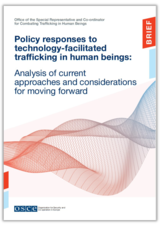
Technology in human trafficking

The development of technology has impacted the crime of trafficking in persons, in ways that present both critical challenges and opportunities. While technology is frequently misused to facilitate trafficking in persons, its positive uses can help practitioners combat trafficking.
Quick links
Turning a liability into an asset
Technology is changing the way human trafficking happens. The internet, smartphones and digital platforms—tools most of us use every day—are also being misused by traffickers to commit crimes, recruit and control victims, move money, and expand their criminal networks across borders, with increasing anonymity.
The rapid development of artificial intelligence and machine learning creates new risks as these tools can replicate human behaviour and enhance trafficking operations. Conversely, law enforcement increasingly uses cutting-edge facial recognition, signal-detection technologies and data management tools to identify suspects and potential victims and enable unprecedented co-ordination between anti-trafficking actors. The Office supports participating States in addressing technology's dual nature, guided by the 2013 Addendum and Ministerial Council Decision 7/17.
News and activities
Current announcements, press releases, media advisories and other updates
Resources
Official OSCE documents, publications and other manually selected resources
Studies and reports
Reports, studies and analyses for policymakers, researchers and all those interested in this field of our work


